While the news breaks that Honda is set to close the doors to its Swindon manufacturing plant in 2021 following a global restructuring, we look back at the history of the plant as we celebrate its 33-year history.
Traces of Honda in the UK can be traced back to its collaboration with British Leyland in 1979. One of the early fruits of this alliance between Honda and BL was the final Triumph-badged car, the Acclaim in 1981. This four-door saloon replaced the ageing Dolomite and was largely based on the Ballade, a Honda model built under licence by BL. The Acclaim sold well and became the first of several successful Rover-badged models jointly developed by Honda and the renamed Austin Rover Group. Although these versions of what were basically Honda designs sold well in the early 1980s, the Japanese manufacturer was carefully watching what Toyota and Nissan were up to in the UK.
With its two main competitors already committed to building new manufacturing plants in this country (Toyota and Nissan), Honda made the decision to establish a pre-delivery (PDI) centre on a former aerodrome close to Swindon in Wiltshire. In 1985 Honda purchased South Marston airfield from Vickers Supermarine and work transforming the site started immediately. Before operations got underway at Swindon, key personnel, referred to at Honda as Associates, were sent to Japan to learn ‘the Honda way’ of vehicle production and receive an insight into the company’s demanding quality standards.

Operations at the new Swindon plant moved into first gear in 1986 when a facility to centralise the pre-sale inspection of all imported and home-built Honda vehicles opened for business. There were excellent reasons for Honda to choose this site; Austin Rover already had a body plant based in the Swindon area and the town was located just over 33 miles away from the former Morris Motors factory at Cowley. Austin Rover and Honda would go on to jointly develop Project XX, the Rover 800 and Project HX, the Honda Legend, and it was decided that both these models would be built at Cowley and not Solihull, the traditional home of Rover.
The agreement between the AR Group and Honda to produce the new big Rover and its Legend-badged sibling in the UK caused alarm bells to ring among Continental manufacturers such as Renault. They saw that unlike the Acclaim, the new Rover was obviously a Japanese car, as most of the hardware used in its manufacture would be produced outside the EEC (as the EU was referred to in those days).
This plan would obviously circumnavigate the ‘gentleman’s agreement’ restricting the import of Japanese cars into the UK and mainland Europe, so a long-term solution had to be found. Managers from Honda and the AR Group entered a tough round of negotiations with the European commission to find a workable solution. The outcome of these protracted talks was that just over 20 per cent of the parts needed to build the new Rover would come from Japan and the rest would have to be sourced and produced in either the UK or EEC.

At the time, Austin Rover was walking a political tightrope with regards to funding and to improve the situation over parts supply, Honda’s logical solution was a simple one. In 1989 the company upped its investment in the UK and opened a large extension at its Swindon plant to produce engines. Up to that time Honda’s Swindon site had mainly been used for PDI purposes, although a section of the factory had produced a few panels for UK-built Ballades.
Since the engine plant had opened for business in 1989, Honda’s Swindon plant had undergone a series of rapid expansions. A second engine assembly line was installed in 1992 and over in Plant One, car manufacturing got underway with assembly of the Accord. In 1994 Honda started producing the Civic at Swindon and the following year established a facility to press body panels on site.

A fully automated press line was set up to process the steel blanks stamped out of huge reels of different grades of steel to form the basic shape of individual body panels. This operation works as follows: the first press stamps out the basic shape and the next one trims the part to remove any excess metal, which is collected for recycling. The panel is then automatically transferred to a third press, which forms flanges for later processes and the final press on the line pierces any holes in the panel required for other fittings.
Despite all the positive news surrounding Honda’s UK operations at the start of the new millennium, the Honda Motor Company was putting a brave face on its ability to build cars in the UK, regardless of whether the country was in or out of the euro. Despite Honda Europe making a loss of more than €300m in 2001, the company’s president summed the financial situation up at the 2002 Paris Motor Show as he unveiled the new Accord by saying: “Success in Europe remains Honda’s biggest challenge”. That problem has seemingly continued to present day…
By 2003, Honda’s Swindon plant had produced 1½ million engines alongside a million cars and the following year the company established a plastics operation on its Wiltshire site. CR-V production at Swindon passed 250,000 in 2004, the same year that marked the 15th anniversary of Honda’s UK plant. In 2005 diesel engine production began at Swindon and as testimony to the global importance of Honda’s UK operations, MD Ken Keir announced that Swindon would be designing and building an upgraded version of the Civic and the UK plant would be the only one geared up to produce the new car.

Honda regarded this as the most important new car launch in the history of its European operations, as the stylish new Civic would not only move the model into an upmarket sector, it would significantly boost the company’s profits. Production of the ninth version of the Civic started the following year and in 2007, Honda’s millionth Civic rolled of the Swindon assembly lines. In 2008 the plant’s plastic moulding operations were expanded and a major milestone at Swindon was reached when the two millionth Honda-badged car was produced.
To prepare the Swindon factory to produce the Honda Jazz, the plant stopped production for four months from February 2009 while the assembly facilities to build the car were transferred from Japan to the UK. Once production restarted, the Swindon plant churned out 20,000 Jazzes in the first six months of production. The new model proved popular with private buyers, with one local dealer claiming to have sold 60 Jazzes out of a single branch over a 12-month period, mainly due to the Government’s controversial scrappage scheme that was running at the time.

Civic Tourer production got underway at Swindon in 2013 and by the end of the following year the original Car Plant One had produced its millionth car. Despite a general fall in new car sales resulting in around 450 jobs being cut at Swindon in 2014, Honda Motor Europe’s president Toshiaki Miksohiba made an announcement early in 2015 that the UK factory was in line for an investment of £200million.
This brought the total investment at the Swindon plant since it first opened for business in 1986 to £2.2billion and with plans to export the next generation of five-door Civic to the US and several exciting new models in the pipeline, Honda of the UK Manufacturing had come along way since Honda’s initial partnership with a struggling British Leyland back in 1979.






